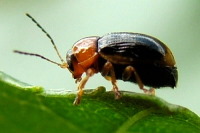Phylum Arthropoda (Arthropods) ➔ Subphylum Hexapoda (Hexapods) ➔ Class Insecta (Insects) ➔ Order Coleoptera (Beetles) ➔ Family Chrysomelidae (Leaf beetles)
Cryptocephalus (Burlinius) pusillus Fabricius, 1777
Kleiner Birken-Fallkäfer
Classification:
Cryptocephalus pusillus belongs to the subfamily Cryptocephalinae, tribe Cryptocephalini.Distribution:
Europe, widespread in Germany at low altitudes.Habitat:
Damp forests, forest margins, clear-cuttings, meadows.Description:
Length 2.5 - 3 mm; upper side yellow-red, underside black except for prothorax; elytra pale reddish-yellow; sulture of elytra, basal edge of the pronotum and the elytra narrowly black-edged, an usually elongated blurred patch on the shoulder and a transverse blurred patch behind the middle of the elytra black-brown; pronotum small, conspicuously narrowed towards the front.The species forms different color forms. Of these the color form marshami Weise can easily be confused with Cryptocephalus rufipes. It has black elytra with a narrow yellow margin, often there is also an arch-shaped yellow patch in front of the tip. Cryptocephalus pusillus differs from Cryptocephalus rufipes by the shape of the pronotum and the significantly shorter and plumper shape.
Biology:
The imagines of Cryptocephalus pusillus appear at the end of June and can be found until September. The species forms one generation per year.Cryptocephalus pusillus lives oligophagous on various deciduous trees and shrubs, often on silver birch (Betula pendula), but also on willows (Salix), poplars (Populus), alders (Alnus), oaks (Quercus) and hazels (Corylus).
The eggs are covered with a scaly coating of a hardening secretion, which often also contains excrements and plant parts, by the females, protecting them from predators, and dropped afterwards on the ground below the forage plant.
After hatching, the larvae live and develop in the foliage layer and pass through 4 larval stages. The larvae feed on wilted leaves and fallen catkins of birches and hazels. They live in a larval case made of dead plant material and faeces, which they carry around constantly and never leave. This is extended by a secretion produced with special anus glands and excreted faeces. To pupate, the larvae climb upwards on plants. The entrance of the larval case is closed. After the pupal period, the beetles leave the larval case through an opening gnawed opposite the original entrance.
References, further reading, links:
- Rheinheimer, Joachim, & Hassler, Michael: Die Blattkäfer Baden-Württembergs, 2018, 928 pages, Kleinsteuber Books (Karlsruhe), ISBN 978-3-9818110-2-5
- Arved Lompe: Die Käfer Europas - Ein Bestimmungswerk im Internet
- Agelastica alni
- Altica sp.
- Aphthona nonstriata
- Bromius obscurus
- Bruchus rufimanus
- Bruchus sp.
- Cassida nebulosa
- Cassida rubiginosa
- Cassida sp.
- Cassida stigmatica
- Cassida vibex
- Cassida vibex/bergeali
- Cassida viridis
- Chrysolina fastuosa
- Chrysolina haemoptera
- Chrysolina hyperici
- Chrysolina lucidicollis
- Chrysolina oricalcia
- Chrysolina sp.
- Chrysolina sturmi
- Chrysolina varians
- Chrysomela populi
- Chrysomela tremula
- Chrysomela vigintipunctata
- Clytra laeviuscula
- Clytra quadripunctata
- Coptocephala sp.
- Crepidodera aurata
- Crepidodera aurea
- Crepidodera fulvicornis
- Crioceris duodecimpunctata
- Cryptocephalinae sp.
- Cryptocephalus moraei
- Cryptocephalus nitidus
- Cryptocephalus pusillus
- Cryptocephalus sp.
- Donacia bicolora
- Donacia cinerea
- Donacia marginata
- Donacia versicolorea
- Galeruca tanaceti
- Galerucella s.l.
- Gastrophysa viridula
- Gonioctena decemnotata
- Gonioctena quinquepunctata
- Gonioctena quinquepunctata/intermedia
- Gonioctena sp.
- Gonioctena viminalis
- Lema cyanella
- Leptinotarsa decemlineata
- Lilioceris lilii
- Lochmaea caprea
- Neocrepidodera ferruginea
- Neocrepidodera sp.
- Oulema melanopus/duftschmidi
- Oulema obscura
- Pachybrachis sp.
- Phratora sp.
- Phratora vitellinae
- Phyllobrotica quadrimaculata
- Phyllotreta armoraciae
- Phyllotreta nemorum
- Phyllotreta vittula
- Plagiodera versicolora
- Plagiosterna aenea
- Plateumaris sp.
- Podagrica fuscicornis
- Psylliodes sp.
- Pyrrhalta viburni
- Sphaeroderma sp.
- Xanthogaleruca luteola

